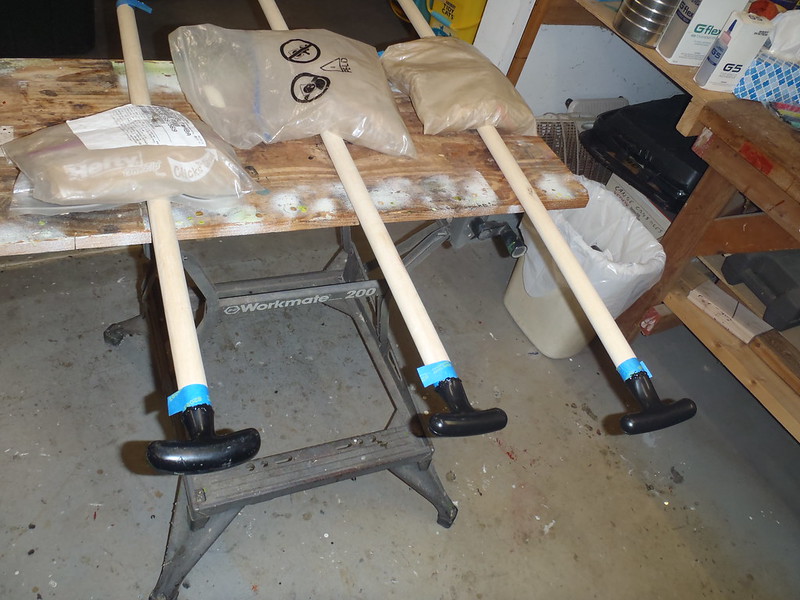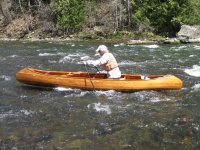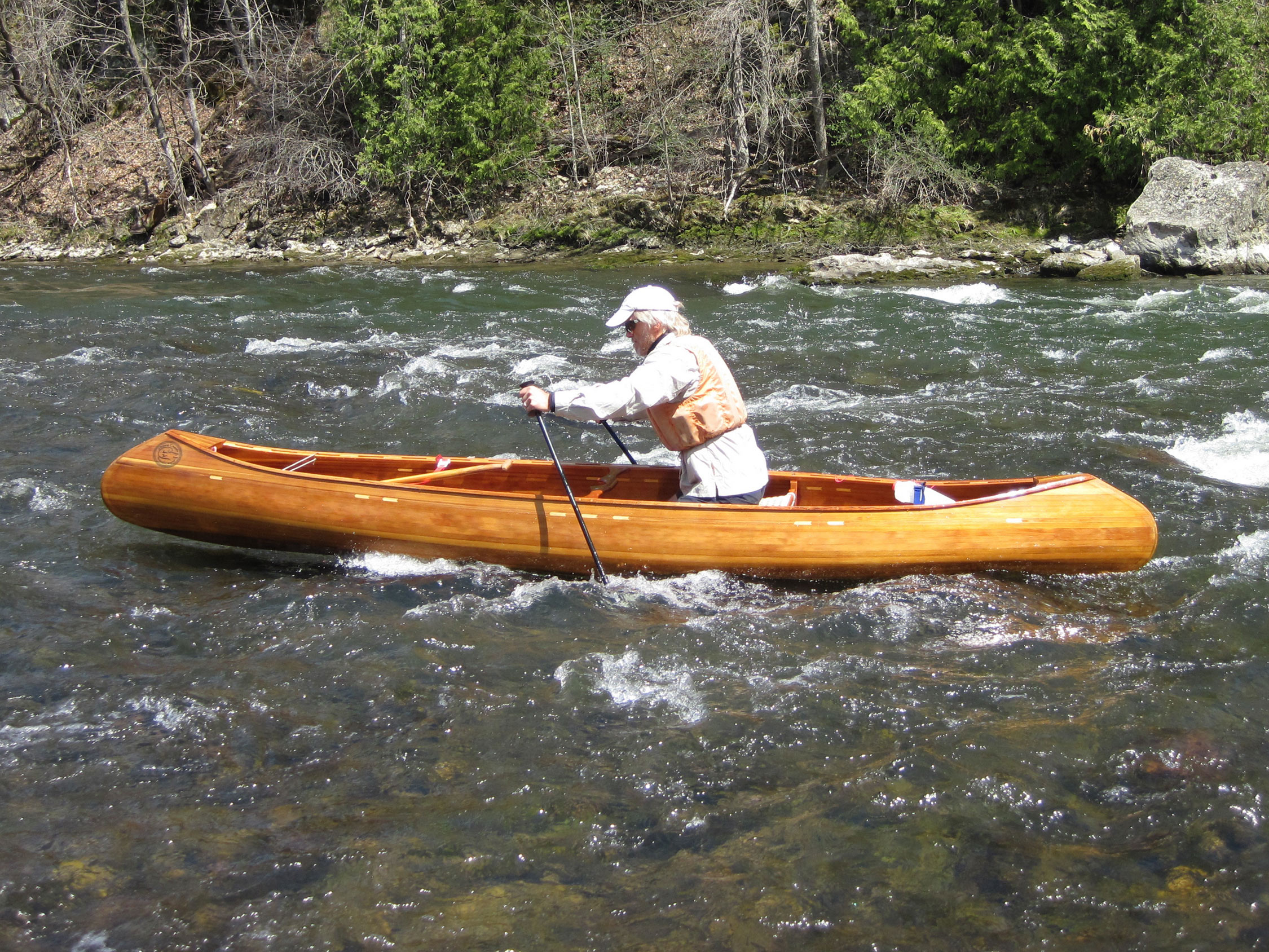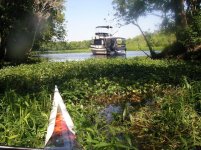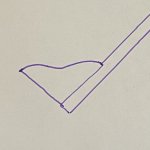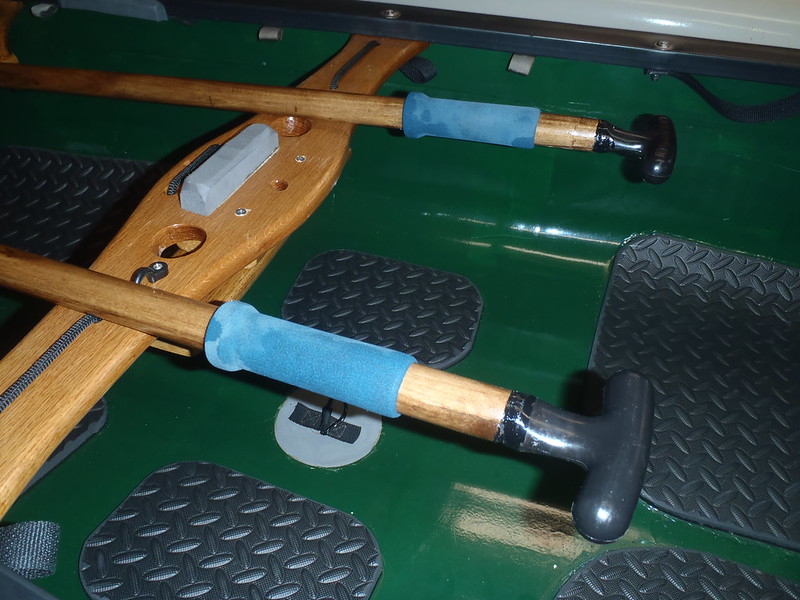- Joined
- Jul 6, 2021
- Messages
- 643
- Reaction score
- 562
The push poles made during the Yellowstone Solo rebuild have been vacationing in Florida with Joel, and I’m told have been post-shoulder surgery rehab helpful for exercising faux paddle strokes.
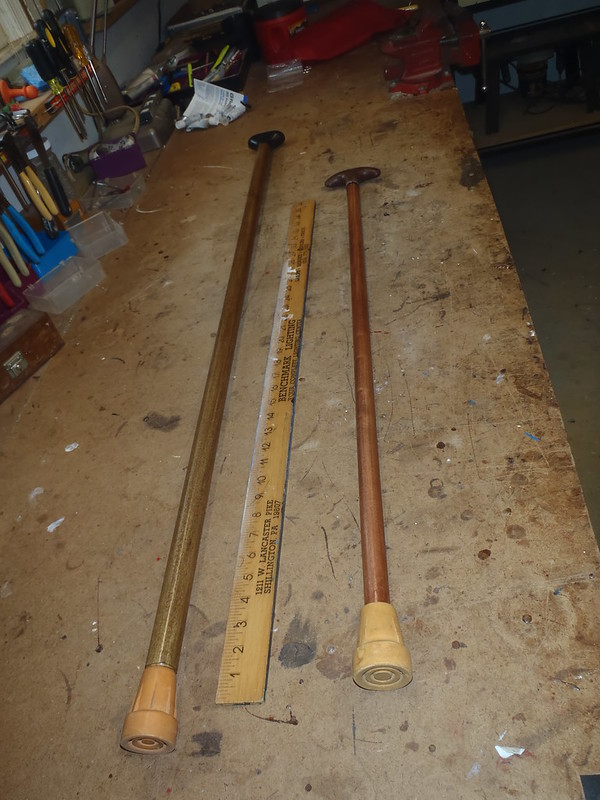 PB280034 by Mike McCrea, on Flickr
PB280034 by Mike McCrea, on Flickr
Although I do wonder what passersby think when they see a man paddling a camp chair with a pole. “Florida Man Attempts to Paddle Chair Across Collier County”. I hope he has the lawn chair properly heeled, doing Helinox freestyle. Photos or it didn’t happen.
While I was amidst sanding and urethaning stages I wanted a couple more short poles. I liked the 5’ length a lot, and it fit on the YS stern cover perfectly.
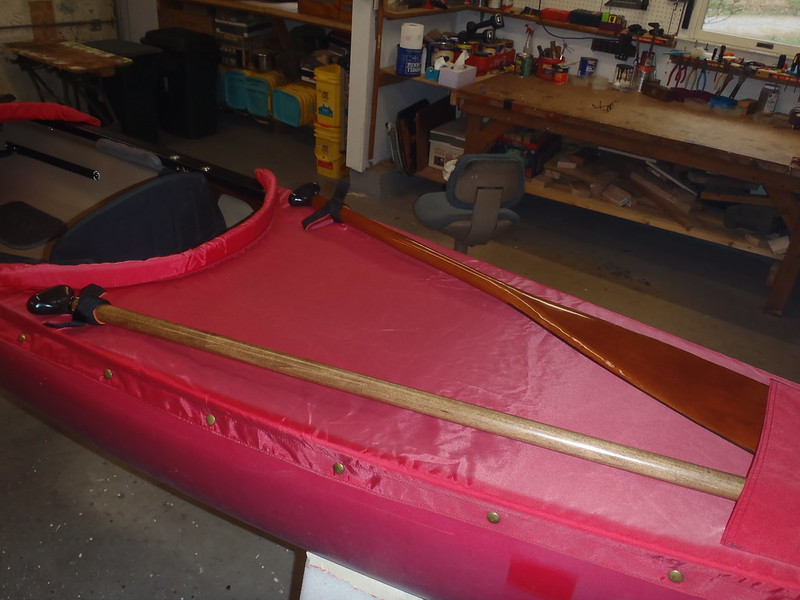 PB280035 by Mike McCrea, on Flickr
PB280035 by Mike McCrea, on Flickr
I wished the five foot pear-gripped pole had a tee for grabby purposes. I also wished I had more T-grips. And whadda ya know, there, in the bottom of a box, I found a bunch more.
Need T-grips, got tee grips. Need shoes, got shoes. Not rubber granny crutch tips this time, something more iron clad for durability, something that will hurt more if I thump someone with it. Not iron, but maybe copper clad; I had a perfectly sized copper pipe cap, and a same diameter length of copper sleeve. What else do I have in the bins of salvage?
A ha, an overfull box of, um, I’m sure that have a name, “peg legs” for tables and stands. I thought they were Roblox or some such, but Googling that only produces a cartoon character app.
https://letmegooglethat.com/?q=Roblox
These things:
 P2050004 by Mike McCrea, on Flickr
P2050004 by Mike McCrea, on Flickr
Like stripping the wheels and casters off anything dumpster bound I wasn’t letting those peg legs go. Guess I need to find a sturdier box for them. No need to sand wood bottoms to fit, just drill holes for right sized pegs on a couple, lubricate with epoxy and slide the stiff shaft in the hole.
Y’all have dirty minds.
The shoes became a little experimental. A plain copper cap, a copper sleeve with a peg leg, and just the peg leg. I never noticed or checked before, but the grid-bottomed pegs are too heavy to be aluminum, and have zero attraction even with a powerful ceramic magnet, so I’m calling those pegs old-laboratory quality stainless.
 P2050005 by Mike McCrea, on Flickr
P2050005 by Mike McCrea, on Flickr
Those just got pricier. Only 30 or 40 left in stock, sizes 1 ½”, 1” and 3/4”. Order yours today. Enter the secret password for free shipping and handling. (Free shipping available only to Main St. USA, or York, New York. Other conditions may apply).
 P2050009 by Mike McCrea, on Flickr
P2050009 by Mike McCrea, on Flickr
Those shorter push poles became two each at 5’ long, and one cane sized for my height at 36 ¾”, including tee grip and shoe. Properly sized, any of the suggested method came up with the same length for my physiology.
https://houseofcanes.com/blog/how-to-measure-and-use-a-cane-properly
Joel’s 38” height pear grip cane is probably near his nipple level. That’s why I didn’t glue the crutch tip in place Joel; saw a few inches of that thing. And when you come north in spring we’ll put a less Granny reminiscent crutch tip shoe on bottom on it. Maybe a sand spike; I have ideas.
Grips and shoes epoxied on, and first coat of urethane laid on the fishing yoke, I couldn’t do much more, certainly not make shop dust. Fortunately Chip paid a shop visit, fulfilling my hermit-like one visitor a month routine. If I’d known he was coming I would have cleaned and organized the shop; I know how fastidious Chip is about shop clutter and organization.
Great visit, talking canoes and gear, roof rack issues(and boasting how I was right a year ago when I said “Just buy a set of VanTech racks, made to fit the transit”), swapping stories and bits of gear. Thanks for the leftover Thule hardware, the air filters for the Tacoma and the books. And I didn’t get you nothing.
Well, not nothing; I couldn’t let Chip leave empty-handed. He seemed to like the ethafoam sawhorse boat stabilizers and, like my pal Berkeley’s companion, uses 2x6’s width-wise as sawhorse crossbars. 2x4, 2x6, doesn’t matter, inverted gunwale are only in flat crossbar contact for a fraction of an inch.
I had just the ticket, four of those giant ethafoam blocks.
 P2040001 by Mike McCrea, on Flickr
P2040001 by Mike McCrea, on Flickr
The stylized W on that hat stands for “WTF am I supposed to do with these?”
I’d been saving those ethafoam blocks for Berkeley’s friend, but he never visits anymore, and won’t go paddling with me. I think it was something I said. I do miss Berkeley though.
 PB280034 by Mike McCrea, on Flickr
PB280034 by Mike McCrea, on FlickrAlthough I do wonder what passersby think when they see a man paddling a camp chair with a pole. “Florida Man Attempts to Paddle Chair Across Collier County”. I hope he has the lawn chair properly heeled, doing Helinox freestyle. Photos or it didn’t happen.
While I was amidst sanding and urethaning stages I wanted a couple more short poles. I liked the 5’ length a lot, and it fit on the YS stern cover perfectly.
 PB280035 by Mike McCrea, on Flickr
PB280035 by Mike McCrea, on FlickrI wished the five foot pear-gripped pole had a tee for grabby purposes. I also wished I had more T-grips. And whadda ya know, there, in the bottom of a box, I found a bunch more.
Need T-grips, got tee grips. Need shoes, got shoes. Not rubber granny crutch tips this time, something more iron clad for durability, something that will hurt more if I thump someone with it. Not iron, but maybe copper clad; I had a perfectly sized copper pipe cap, and a same diameter length of copper sleeve. What else do I have in the bins of salvage?
A ha, an overfull box of, um, I’m sure that have a name, “peg legs” for tables and stands. I thought they were Roblox or some such, but Googling that only produces a cartoon character app.
https://letmegooglethat.com/?q=Roblox
These things:
 P2050004 by Mike McCrea, on Flickr
P2050004 by Mike McCrea, on FlickrLike stripping the wheels and casters off anything dumpster bound I wasn’t letting those peg legs go. Guess I need to find a sturdier box for them. No need to sand wood bottoms to fit, just drill holes for right sized pegs on a couple, lubricate with epoxy and slide the stiff shaft in the hole.
Y’all have dirty minds.
The shoes became a little experimental. A plain copper cap, a copper sleeve with a peg leg, and just the peg leg. I never noticed or checked before, but the grid-bottomed pegs are too heavy to be aluminum, and have zero attraction even with a powerful ceramic magnet, so I’m calling those pegs old-laboratory quality stainless.
 P2050005 by Mike McCrea, on Flickr
P2050005 by Mike McCrea, on FlickrThose just got pricier. Only 30 or 40 left in stock, sizes 1 ½”, 1” and 3/4”. Order yours today. Enter the secret password for free shipping and handling. (Free shipping available only to Main St. USA, or York, New York. Other conditions may apply).
 P2050009 by Mike McCrea, on Flickr
P2050009 by Mike McCrea, on FlickrThose shorter push poles became two each at 5’ long, and one cane sized for my height at 36 ¾”, including tee grip and shoe. Properly sized, any of the suggested method came up with the same length for my physiology.
https://houseofcanes.com/blog/how-to-measure-and-use-a-cane-properly
Joel’s 38” height pear grip cane is probably near his nipple level. That’s why I didn’t glue the crutch tip in place Joel; saw a few inches of that thing. And when you come north in spring we’ll put a less Granny reminiscent crutch tip shoe on bottom on it. Maybe a sand spike; I have ideas.
Grips and shoes epoxied on, and first coat of urethane laid on the fishing yoke, I couldn’t do much more, certainly not make shop dust. Fortunately Chip paid a shop visit, fulfilling my hermit-like one visitor a month routine. If I’d known he was coming I would have cleaned and organized the shop; I know how fastidious Chip is about shop clutter and organization.
Great visit, talking canoes and gear, roof rack issues(and boasting how I was right a year ago when I said “Just buy a set of VanTech racks, made to fit the transit”), swapping stories and bits of gear. Thanks for the leftover Thule hardware, the air filters for the Tacoma and the books. And I didn’t get you nothing.
Well, not nothing; I couldn’t let Chip leave empty-handed. He seemed to like the ethafoam sawhorse boat stabilizers and, like my pal Berkeley’s companion, uses 2x6’s width-wise as sawhorse crossbars. 2x4, 2x6, doesn’t matter, inverted gunwale are only in flat crossbar contact for a fraction of an inch.
I had just the ticket, four of those giant ethafoam blocks.
 P2040001 by Mike McCrea, on Flickr
P2040001 by Mike McCrea, on FlickrThe stylized W on that hat stands for “WTF am I supposed to do with these?”
I’d been saving those ethafoam blocks for Berkeley’s friend, but he never visits anymore, and won’t go paddling with me. I think it was something I said. I do miss Berkeley though.

